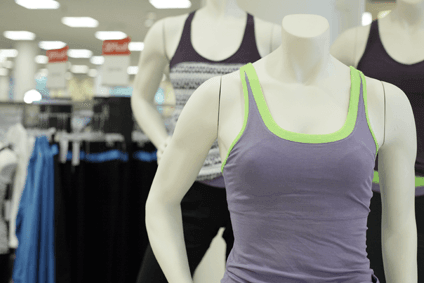
The global spandex market is growing at more than double the rate of all fibres activity, with sales set to pass 1 million tonnes next year as the stretch fibre firmly establishes itself as a core textile product.
But industry structures will need to change to meet competition from China – which dominates production capacity – and the challenge of closed-loop recycling, according to Wood Mackenzie Chemicals research.
Its ‘Global Spandex Market Report 2019’ calculates that global spandex consumption currently sits at 860kt, and by the end of next year will pass the significant 1 million tonne mark.
“Given that spandex is invariably a minority component of textile fabrics, with just 2-3% content sufficient to deliver comfort stretch, it is evident that this 1 million tonnes of spandex actually projects a very powerful footprint across global textiles,” says David Hart, Wood Mackenzie Chemicals senior consultant.
China dominates spandex industry
China is leading the global market, with 75% of global production capacity. Spandex recently hit the headlines with the $2.4bn takeover of The Lycra Company business by Shandong Ruyi of China.
How well do you really know your competitors?
Access the most comprehensive Company Profiles on the market, powered by GlobalData. Save hours of research. Gain competitive edge.

Thank you!
Your download email will arrive shortly
Not ready to buy yet? Download a free sample
We are confident about the unique quality of our Company Profiles. However, we want you to make the most beneficial decision for your business, so we offer a free sample that you can download by submitting the below form
By GlobalData“However, in practice, spandex has been making powerful progress in global textile markets for the last 15-20 years. What was once regarded as a small-scale specialist yarn is now moving into centre-stage as a key partner in many apparel products,” Hart adds.
According to the report, the current decade has seen aggressive spandex market growth of just over 9% CAGR – almost three times the average growth for total fibres.
The key driver is the purchasing power of an emerging global middle class, which is demanding sophisticated sportswear, intimate apparel and shapewear, together with form-fitting and comfortable everyday apparel.
The speed with which spandex has broken out from its traditional US and European markets to address a massively growing Asian opportunity indicates the globalisation of spandex demand still has some way to run.
“Looking at textile mill demand, 84% of spandex is consumed within Asia, with 9% in Greater Europe and 7% in the Americas. Despite the low shares in western markets, the absolute mill consumption has continued to rise as residual high-value textile products increasingly use spandex. But Asia is undoubtedly the growth focus,” continues Hart.
Spandex winning the battle for supremacy
“Stretch and fit are primary requirements in apparel and spandex is by far the most effective mechanism to supply these. Other stretch product types compete for this market, with natural rubber the leading challenger, but spandex continues to extend its market leadership at around 67% of current total stretch yarn activity.
“Spandex offers finer yarns and greater uniformity than rubber and provides an effective partnership across a full range of natural and man-made fibres. And with low percentage content in textile products, it allows the aesthetics of cotton, wool, linen or other fibres to express themselves without compromising the stretch component.
“Spandex has also seen its relative pricing fall over the past twenty to thirty years from around ten times that of a nylon yarn down to approximate price equivalence. This allows desirable stretch properties to be introduced without imposing a significant cost premium.”
Leading group of Chinese spandex suppliers is emerging
We have seen a significant reshaping of the Chinese spandex manufacturing industry over the past 10 years.
Foreign investors into China, such as Hyosung, have upped their spandex capacities but at rates that are below total market growth. They have consequently seen their share of total Chinese spandex production slip to 23%, with the smaller opportunistic Chinese investors falling back to around 14%.
A small but influential group of 5-6 Chinese spandex producers is expected to become more influential in the market, currently sitting at 64% of Chinese manufacturing activity.
“Why is this significant? Chinese spandex producers have largely been preoccupied with the impressive growth of domestic Chinese spandex demand. This has been spurred by the challenge of the latest China Five Year Plan to upgrade textile output to compensate for higher Chinese labour costs.
“This strong domestic market focus has limited China’s spandex export activity, which is also limited by the very simple Chinese service package in relation to what is still a specialist yarn category.
“The emergence of these powerful Chinese players with more complex resources appears to suggest that China will soon seek as international a role in spandex as it has in other synthetic fibre sectors. Global spandex competitors should certainly take note,” Hart says.
Spandex industry needs to solve environmental puzzle
The global textile industry is making significant efforts to respond to environmental challenges through its choice of raw materials, including recycled plastic bottles and manufacturing processes.
“The industry is facing up to the fact that it will be tasked with using more raw materials that have been recycled from within the supply chain in order to create a closed-loop system comprising of end-of-life textile products.
“A critical parameter in this process is the uniformity of raw material content of this recyclable material. Put simply, the more uniform the content, the greater the recycling potential.
“Spandex is used in blends of 3% to 30% with other fibres such as polyester, nylon and cotton. This minority content could potentially impede efforts to recycle majority components in the textile blend.
“However, spandex suppliers are aware of this issue and will need to respond to ensure they are on the right side of the environmental debate,” Hart concludes.



